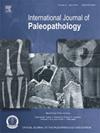From privies to disease: Parasites and pollen from 19th century Québec City
IF 1.5
3区 地球科学
Q3 PALEONTOLOGY
引用次数: 0
Abstract
Objective
This project combines the analysis of parasites and pollen remains from a wealthy 19th century household in Québec City, Canada to examine health as it intersects with ecological and cultural factors of disease transmission in changing urban environments.
Materials
Nineteen sediment samples from two privy structures from a 19th century wealthy household in Québec City, Canada.
Methods
The parasite analysis was conducted by examining the sediment through acid digestion, deflocculation and micro-sieving, and observed under a brightfield microscope. Pollen analysis followed the same method, but the sediments were further treated with acetolysis before microscopic observation.
Results
The samples tested positive for the parasites Trichuris trichiura, Ascaris lumbricoides and capillariids. The pollen spectra showed a mixed diet based on species of cereals and other starchy foods, fruits, and green leaves, as well as condiments and potential medicinal ingredients (Myrtaceae).
Conclusions
The household members were infected with intestinal parasites spread through contact with fecal contaminated soils, suggesting deficient sanitation and hygiene. The pollen grains recovered evidence of a staple diet and medicinal remedies.
Significance
This project highlights the benefits of using multiple lines of evidence to understand health in the past. Insight into how urbanization and poor sanitation can create environments conducive to parasite infection is gained and expands our knowledge of disease transmission and the synergies between environment and disease.
Limitations
The analysis of privy structures offers an interpretation at the community level, masking individual idiosyncrasies.
Suggestions for further research
Similar studies on other contemporaneous sites across the city are needed to better comprehend the link between pathogen transmission, disease intensity and socioenvironmental factors.
从厕所到疾病:19世纪曲海贝市的寄生虫和花粉
目标本项目结合对加拿大魁北克市一个 19 世纪富裕家庭中的寄生虫和花粉残留物的分析,研究在不断变化的城市环境中,健康与疾病传播的生态和文化因素之间的相互关系。花粉分析采用了相同的方法,但在显微镜观察之前,沉积物还要进一步进行乙醇分解处理。花粉图谱显示,该家庭的食物以谷物和其他淀粉类食物、水果、绿叶以及调味品和潜在的药用成分(桃金娘科)为主。花粉粒中发现了主食和药用疗法的证据。对厕所结构的分析提供了社区层面的解释,掩盖了个体的特异性。进一步研究的建议需要对全市其他同时代的遗址进行类似的研究,以更好地理解病原体传播、疾病强度和社会环境因素之间的联系。
本文章由计算机程序翻译,如有差异,请以英文原文为准。
求助全文
约1分钟内获得全文
求助全文
来源期刊

International Journal of Paleopathology
PALEONTOLOGY-PATHOLOGY
CiteScore
2.90
自引率
25.00%
发文量
43
期刊介绍:
Paleopathology is the study and application of methods and techniques for investigating diseases and related conditions from skeletal and soft tissue remains. The International Journal of Paleopathology (IJPP) will publish original and significant articles on human and animal (including hominids) disease, based upon the study of physical remains, including osseous, dental, and preserved soft tissues at a range of methodological levels, from direct observation to molecular, chemical, histological and radiographic analysis. Discussion of ways in which these methods can be applied to the reconstruction of health, disease and life histories in the past is central to the discipline, so the journal would also encourage papers covering interpretive and theoretical issues, and those that place the study of disease at the centre of a bioarchaeological or biocultural approach. Papers dealing with historical evidence relating to disease in the past (rather than history of medicine) will also be published. The journal will also accept significant studies that applied previously developed techniques to new materials, setting the research in the context of current debates on past human and animal health.
 求助内容:
求助内容: 应助结果提醒方式:
应助结果提醒方式:


